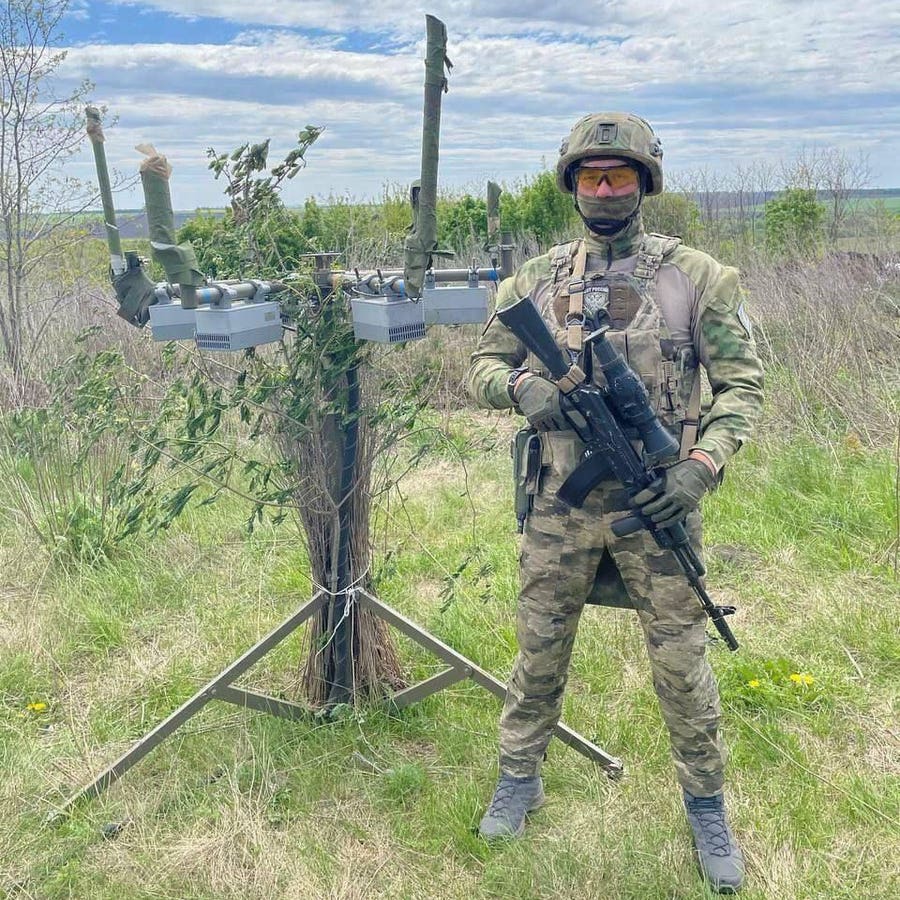Russian force in Ukraine deploy Silok radio-jammers in order to disrupt the radio links between Ukrainian drone and their operators.
But the Ukrainians have knocked out several Siloks. With drones. Most recently, a Mavic quadcopter from Ukraine’s Aerobomber unit bombed, with grenades, a tripod-mounted Silok—apparently destroying it.
Add the drone raids on Silok counter-drone systems to the long, and lengthening, list of ironic operations by Ukrainian forces. Ukrainian artillery blasting a Russian counter-artillery radar. A Ukrainian GPS-guided bomb blowing up a Russian GPS-jammer. And many, many examples of Ukrainian drones bombing Russian drone-jammers.
Jamming= broad spectrum noise source that is louder at the frequency than the signal of the transponders. In other words, a high power homing beacon that is stationary and always needs to broadcast.
“Oh look! Our drone got jammed.”
“That’s okay. It returns home on its own.”
“Where is home?”
“The jamming beacon.”
Something like that…
but it’s not continuous, it’s a few commonly used sections that are jammed. This way you get more range out of the same power, until somebody uses freqs in the gaps and you can’t adjust. And then some are broken, some are off, some don’t work, and we know that jamming doesn’t always work because there was one video of bomber drone destroying jammer. If it was home-on-jam the signal would drown in noise
SDR? It has to be the largest signal in the area right?
Move to 3 points to triangulate quickly when signal is lost to noise and vector to the location regardless of continuous transmission.
I want to know why anti-drone systems are not simply using diode lasers and simple trackers to blind/fry the optics. Seems to me that a system should be about as cheap as the average drone, and they all seem to rely heavily on optical sensors.
do you have any idea how big antenna array has to be for it to have any angular resolution
Nope
you need something like square array sized at about 2 wavelengths wide, this can easily get into 50x50cm range at lower frequencies
I want to know why anti-drone systems are not simply using diode lasers and simple trackers to blind/fry the optics
because you have to find drone first, acquire its location and quite precisely at that, and at this point short burst of 12.7mm is more reliable. jammers don’t need any directivity and work over any number of drones in area covered
Guns are heavy and slow. Light is near instantaneous and has no trajectory. A targeting laser can move extremely fast and a 360° camera with AI object recognition can pick up targets faster than any human. Targeting does not need to be accurate as a common high power diode laser can fry any optical sensor upon contact. Just aim and add a little jitter in the region of the issue. It should also be possible to use UV lasers that are outside of the visual spectrum. It is not hard to spot these with optics designed for the task, but most military optics seem to focus on IR, so UV should be much less visible while being much higher energy and causing more damage quickly. It should be possible and not require the radio emissions of a jammer.
lasers with power required would be also pretty heavy, and only as fast as operator, so about the same as AA guns
That’s pretty much like Wild Weasel SEAD works. Get locked on by a SAM radar, lock your HAARM to that radar’s signal and press fire🙂
You forgot the “Blyat.” As it dawns on the Russians.
Preface: I know nothing about weapons except “point sharp end away from self”.
The article has a video. The video shows drones dropping hand grenades at the jammers. The grenades go off (in a spectacularly disappointing fashion compared to what’s depicted in movies, but that’s beside the point) but don’t seem to damage the jammers in any meaningful way. So, do the videos in fact show effective destruction even if it doesn’t look like it?
Post script: I am not a Russian troll. Long live Ukraine! 🇺🇦🖖😎 I am merely not understanding the videos very well.
What you see in movies is bullshit. Any explosion creates a huge fireball and people go flying in every direction. Actual munitions aren’t like that. Especially munitions that have to be carried on light little drones. That includes most hand grenades and air-dropped bombs.
I’m concept, an explosion that creates that big fireball puts most of its energy into spreading burning fuel around to create that big fireball. It’s visually impressive, but not actually very destructive. In warfare you don’t care what it looks like, you want it to be destructive. And the best way to get bang for your buck so to speak with an explosive that has to be lightweight, is with shrapnel. An explosive wrapped in shrapnel is not visually impressive to watch, but it basically sends little bullets flying out in every direction and those bullets are what does the damage.
So consider it this way. If I walk up to the jamming device and shoot it with a pistol, it’s not going to be visually impressive. Nothing is going to fly apart and explode in a shower of sparks and flames. The jammer device might not even move at all, it just now has a hole in it. But it is in fact quite thoroughly destroyed because the bullet from my pistol destroyed all of its internal workings.
Same thing is true with the grenade. The hand grenade is designed to be light and effective, so a soldier can carry it without getting weighed down. Thus it is a small explosive wrapped in a lot of shrapnel. Soldier throws it at the enemy, enemy casualties come not from the explosion but from shrapnel wounds. Drop one of those grenades next to a piece of equipment that isn’t armored, and it may not even appear to move, but it has been quite thoroughly punctured by shrapnel and is thus destroyed.
Hand grenades produce shrapnel. Having loads of tiny holes in it generally isn’t conducive to the functioning of electronic equipment.







